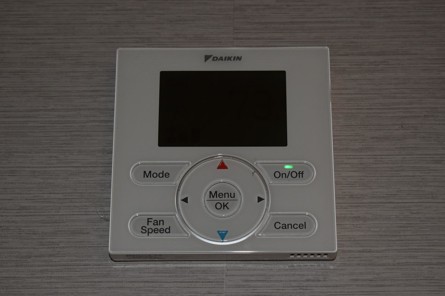One beneficial DIY you can learn as a homeowner is how to reset thermostat settings. A thermostat is a heating and cooling system component that measures and controls the home’s temperatures. You must know how the thermostat works before buying one.
Before resetting your thermostat, first know its type, which will help you understand how it is reset. For example, a programmable thermostat has a different resetting procedure from an air conditioner. This article explores how to reset each type of thermostat.
That said, let’s get started!
How Thermostats Work
A thermostat maintains constant temperatures in the house. It has temperature sensors to know when the place is too hot or too cold and turns the heating and cooling system on or off to adjust the temperatures.
The two major types of thermostats are line voltage and low voltage. The line voltage thermostat is user-friendly and easy to install. It comes ready to be plugged into the socket and has a high voltage consumption.
The low voltage thermostat is a direct wired heater and AC control. It works with many systems, including boilers, furnaces, radiant heat, and air conditioning. A low voltage thermostat uses a small battery, which can recharge and snap power from the mainline.
The other types of thermostats are non-programmable, programmable, air conditioner, and electronic thermostats. Before learning how to reset the thermostat, let us first look at how each works.
1. Non-Programmable Thermostat
Also called the manual thermostat, a non-programmable thermostat comes with a dial to adjust the temperatures. However, you can get an electrical non-programmable thermostat with a digital display.
These thermostats are best for homes where temperatures don’t vary much. The homeowner can survive with a single setting of the temperatures they are comfortable within the house.
2. Programmable Thermostat
You can set different schedules to control the home’s temperatures with your programmable thermostat. The device also allows homeowners to customize the set with varying temperatures. These thermostats have more features than non-programmable ones.
3. Mechanical Thermostat
Mechanical thermostats are cheap and easy to install. They have bi-metallic strips that react to changes in the temperatures. However, these have a disadvantage. Since they have a slow response, homeowners deal with significant temperature variations.
How To Reset Air Conditioner Thermostat
Once you know the type of your thermostat and how it works, you can easily reset it. First, read the directions in the user’s guide, or ask a professional. These easy-to-follow guides will help you with resetting your thermostat.
1. Resetting An Air Conditioner Thermostat
You don’t need an expert to reset your air conditioner thermostat, but you can ask them for guidance. Before starting, shut down your AC thermostat at the AC unit. Then, ensure the thermostat is in the OFF position.
Find the circuit breaker box to ensure no electricity supply to the HVAC system and other items. The breaker box could be in the basement or the closet. The next step is to turn off the circuit breaker for your AC unit.
Wait for 30 seconds to turn on the circuit breaker box. Next, turn the AC thermostat back on, and turn on the air conditioning unit. You can now set the temperatures and wait to see if there are changes.
2. Resetting A Programmable Thermostat
Now that you know how to reset ac thermostat, resetting a programmable one is easy because you do it with a battery change. Start by switching the thermostat to the OFF position and then open the device’s battery department.
Since most thermostats are placed on the wall, and the battery door is at the back, you must first uninstall it to access the door. Use a coin or something with a slender tip to open the part and remove the battery.
Once you remove the batteries, put them back but facing the opposite direction. For example, the positive terminal of the battery should be facing the negative terminal of the thermostat. Leave them for five seconds and place them in their correct alignment.
If your thermostat’s display turns on, you have successfully reset it. The resetting should also fix the programming and connection issues.
3. Resetting A Mechanical Thermostat
Mechanical thermostats are manually operated. The homeowner turns the device on, sets it, and switches it off manually. Unfortunately, these do not run on battery, so they require resetting of the circuit breaker.
To start the resetting, turn the thermostat off by switching it to the OFF position. Find the circuit breaker that supplies power to the HVAC and put it in the OFF position. Wait for about 30 seconds to switch on the thermostat.
Before switching the thermostat to the ON position, turn on the circuit breaker. Next, switch on the thermostat and check if it is working. This completes your resetting.
4. Resetting A Non-Programmable Thermostat
Resetting a non-programmable digital thermostat is easy. Start by pressing the reset button for five seconds or removing the batteries. Let the device stay for five seconds before returning the batteries. Once you return the batteries and the thermostat is working, it is reset.
5. Resetting Line Voltage And Low Voltage Thermostat
The line voltage and low voltage thermostats do not have a digital display. Instead, they have a baseboard heating or a direct-wired furnace. To reset them, start by removing the thermostat cover.
Next, clean the inside components with a brush and set the thermostat to the lowest cooling setting. Then, use a soft-bristled brush to clean the components again. Finally, set the device to the highest heating setting and clean the coil again. Finish by resetting the thermostat to the temperatures you want.
Thermostat resetting is essential if you suspect your device has become faulty or your home’s temperature is undesirable. You can do the resetting after a change in season, like after winter or summer, to keep up with the current climatic temperatures.
Final Words
If you don’t know how to reset thermostat settings after reading the user’s manual, call a professional to do it. Leaving experts to operate your devices ensures their safety and longevity. However, you can ask them to guide you until you know how to do it yourself.






